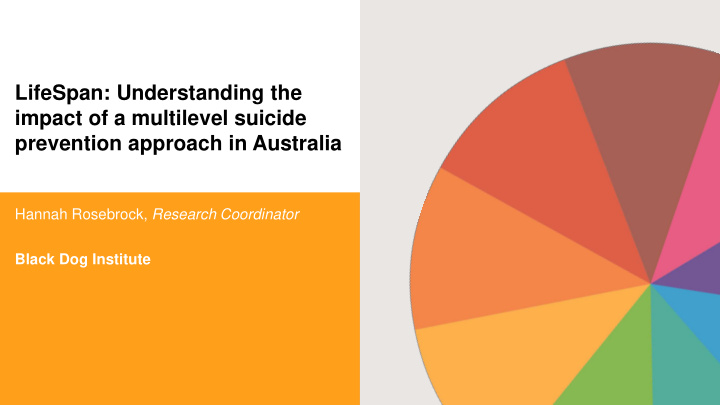



LifeSpan: Understanding the impact of a multilevel suicide prevention approach in Australia Hannah Rosebrock, Research Coordinator Black Dog Institute
Who we are… Black Dog Institute (BDI) is a translational medical research institute Discovery: causes of mental ill-health, new treatments Translation: research into practice through health services, technology and community education
What is LifeSpan? LifeSpan is an evidence-based, multilevel approach to integrated suicide prevention. It combines nine strategies that have strong evidence for suicide prevention into one community-led approach, incorporating health, education, frontline services, business and the community; simultaneous implementation. Strategies span population-level to indicated intervention to reach everyone Local adaptation , governance, data-driven decisions, and delivery is key.
Evaluating the LifeSpan Crisis Care and Aftercare strategy
Key components of coordinated assertive aftercare 1. Rapid follow up – within 24 hours of discharge 2. Assertive follow up – telephone, text, home visits 3. Ongoing assessment and planning 4. Coordination of clinical and non- clinical care 5. Support to stick with treatment 6. Problem-solving counselling Shand, Vogl, Robinson (2018). Improving patient care after a suicide attempt. Australasian Psychiatry; 26 (2), 145-148
An example: OPAC • Outreach, Problem solving, Adherence, Continuity • Six months of care • Average 8 home visits or calls • Single point of contact • Reduced the number of people who re- attempted during the next 12m (8.7% vs 21.9%) • 5-year follow-up – difference remained significant up to 265 weeks Key Point: Rapid and assertive follow up is essential
Study design • 3 parts = 3 different datasets Routinely collected data – linkage • ED Data, Hospital and Psychiatric Admissions, Comparison of LifeSpan sites and Community Health Data, Mortality, MBS, PBS treatment-as-usual sites • Follow a group of people over time Survey Currently recruiting Standardised questionnaires Individuals at risk of suicide Carers Qualitative interviews Healthcare professionals Patients Carers Health care • What are their healthcare experiences? • Do healthcare experiences change?
RECRUITMENT for survey Two recruitment strategies: 1. Online: Six Facebook ads live for the duration of one month. 2. Face-to-Face: Various strategies depending on site. Ideas welcome! Who is eligible to participate in the survey? Individuals who have presented to the ED for thoughts of suicide or suicide attempt in the past 18 months, aged 16 and over Do you have a moment to participate in this study?
That’s easy. Start looking at your governments enabling poverty in so Not related to this article but I have a called societies. We all live on a petri chronic depressive disorder and am dish designed to enslave the many like having a great deal of negative effects any other social experiment. being related to the ‘one size fits all’ approach of disability support providers causing myself to sink into a despondent depression. If I wasn’t so depressed and I had the energy I would participate. […] I’ve tried some of those services and What about interviewing parents there were issues with some of them. of teenagers that have attempted I’m happy to help with your studies and to commit suicide provide info. I have had 25 years worth dealing with this. Things do need to Can this be done from a change and methods for help […] carers/parent perspective?
Ethics approved Recruitspirations • Distribution of flyers in waiting areas, discharge packs etc. • Telling eligible participants about the study. Take verbal consent and pass on contact details on to research team. • Hand-out information packs (Participant Information & Consent Form & Phone Helpline Numbers in envelope)
Hannah Rosebrock | Research Coordinator | h.rosebrock@blackdog.org.au
Recommend
More recommend